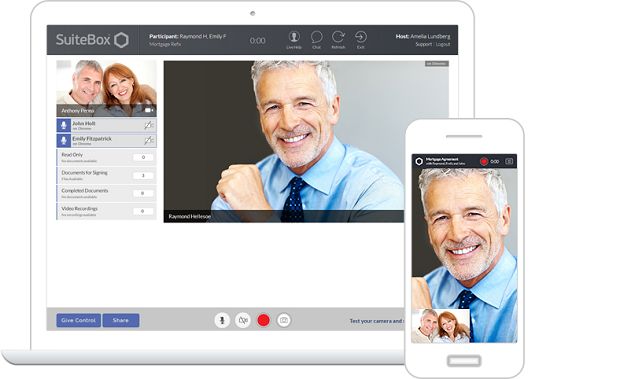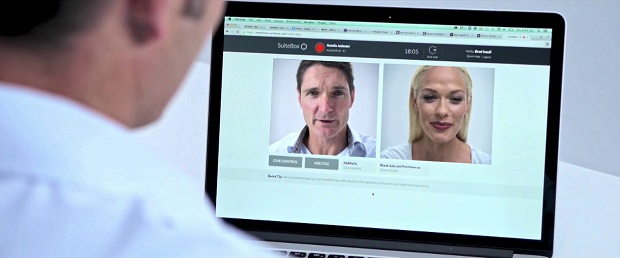* – This article has been archived and is no longer updated by our editorial team –
SuiteBox is a leading provider of content-based collaboration software. The company now operates in the US, Canada, UK, South Africa, Australia, and New Zealand. To learn more about SuiteBox, see our recent interview with the CEO Ian Dunbar:

Q: SuiteBox recently released its newest technology enhancement: VideoSign Proof of Signature. Tell us about this new evolution of signature capture.
A: For hundreds of years, a signature was handwritten in ink. Validity was established by having an individual witness a signing of a document, by comparing a signature to a record held on file. In the case of a serious dispute a handwriting expert would examine a signature against the handwriting of the signer and determine if in their opinion the signature was real.
The problem for modern businesses is that these processes are manual and costly, yet regulators more often are demanding higher standards of proof, evidence, and documentation. Business is lost and delayed as the signing of documents becomes cumbersome, especially where multiple parties and jurisdictions are involved.
Advances in electronic and digital signing tools have substantially streamlined document signing with ‘click-to-sign’ capabilities. However, there exists a significant weakness where there is no guarantee that the person who clicks the button and enters a name is the person who is intended to do the signing. Indeed, a California Bankruptcy Court has found that simple ‘click-to-sign’ technology is not suitable for the signing of legal documents.
SuiteBox VideoSign Proof of Signature addresses these risks by combining the speed and convenience of digital signing technology with an unsurpassed audit trail and video capture of the signing transaction. This provides the evidence that the person signing the document is in the meeting and is executing the transaction himself.
SuiteBox captures all of the digital data used in ‘click-to-sign’ tools like DocuSign, as well as capturing photo images of the signer, a video stream of the event, and the ability to attach evidence of identity, such as a driver’s license or passport image, into the signed document.
 Recommended: Krome Photos Aims To Transform How Image Is Created
Recommended: Krome Photos Aims To Transform How Image Is Created
Q: Could you provide our readers with a brief introduction to SuiteBox?
A: SuiteBox is a leading provider of content-based collaboration software, founded in Auckland, New Zealand. SuiteBox now operates in the US, Canada, UK, South Africa, Australia, and New Zealand.
SuiteBox uniquely combines video and voice, document collaboration, digital signing and recording into the digital equivalent of a physical meeting room. A SuiteBox room can be opened for the duration of a business relationship or transaction, with participants able to meet, share documents, and sign documents. All content of the meeting is recorded and retained, delivering the highest level of proof, evidence, and documentation, satisfying the highest of regulatory requirements.
Q: What is the difference between Electronic Signatures and Digital Signatures?
A: An electronic signature is any processes whereby approval and acceptance are undertaken, using an electronic means. This includes such tools as replying to an email indicating acceptance, or even the act of scanning a signed document (such that the signature is now an electronic artifact).
The risk associated with electronic signatures is that it may be difficult for the party accepting the signature to prove beyond doubt that the electronic signing was undertaken by the intended individual and that there has not been any tampering or changes made after acceptance.
A digital signature applies a much higher standard of controls to prevent the tampering of documents. A digital signature is based on cryptography, which uses mathematical formulas, or algorithms, to scramble messages. Using encryption and decryption software, the sender can scramble the message, and the recipient can unscramble it, using what are called ‘keys.’ The digital signature applied to the document is ‘certified’ as being original. If a digitally signed document were tampered with in any manner, the certificate would no longer be valid, and fraud would be detected.
However, as outlined above, the weakness of click-to-sign digital signing solutions is that the person who clicks to sign cannot be validated, only that someone used the computer keyboard to sign. Only through the inclusion of photo and video evidence can this risk be addressed.
 Recommended: Open Invention Network Enables Freedom Of Action In Linux
Recommended: Open Invention Network Enables Freedom Of Action In Linux
Q: How can SuiteBox VideoSign™ help free up time?
A: One of the biggest impediments to efficient business is the challenge of arranging meetings, reviewing and agreeing to document content, and getting documents signed, with accurate record keeping. This ‘friction’ in everyday business adds costs, creates significant delays and can lead to lost business opportunities. For example, home loan refinancing can see up to 70% of business lost at the final stage of signing documentation.
SuiteBox saves time, accelerates business closure and increases completion rates across many industries by allowing parties to meet anytime, anywhere to review and agree on the document content and close the business through immediate signing without delay. All safely and securely recorded for future reference if needed.
Our clients on average reported saving 4.5 hours per week and hundreds of kilometers of travel in a year.
Q: What are your plans for the future?
A: SuiteBox is rapidly accelerating our growth in the USA and the other markets in which we operate. We are actively working with clients across financial services, real estate and property closure, legal services, accounting, and homeschooling.
In early 2018 we will be unveiling further advances in ease of record keeping, such as easy conversion of voice streams into text records, and in support of hearing-impaired users. These upcoming advances will enable our clients to enhance their compliance and record keeping further, and fulfill crucial corporate responsibility obligations while enhancing the speed of closing business.

